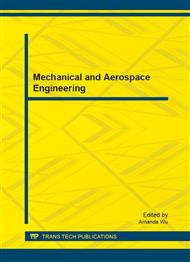[1]
Y. Sahin, K. Ozdin, A model for the abrasive wear behaviour of aluminium based composites, Mater. Des. 29 (2008) 728-733.
DOI: 10.1016/j.matdes.2007.02.013
Google Scholar
[2]
Y. Sahin, S. Ozkan, Dry wear behaviour of SiCp/2014 Al alloy composite, Proceedings of the 2nd European Conference on Tribology, ECOTRIB 2009, Engineering Faculty, University of Pisa, E. Ciulli, B. Piccigallo, R. Bassani, J. Vizintin, R. Crockett (Edit. ), pp.337-342.
Google Scholar
[3]
Y. Sahin, Kompozit Malzemelere Giriş, Seckin Yayın&Dağıtım, Ankara/Turkey, (2006).
Google Scholar
[4]
S. Das, D. P. Mondal, G. Dixit, Correlation of abrasive wear with microstructure and mechanical properties of pressure die-cast aluminium hard-particle composite, Metal. Mater. Trans. 32A (2001) 633-638.
DOI: 10.1007/s11661-001-0080-3
Google Scholar
[5]
R. L. Deuis, C. Subramanian, J.M. Yellup, Abrasion wear of Al composites-a review, Wear 201 (1996) 132-144.
DOI: 10.1016/s0043-1648(96)07228-6
Google Scholar
[6]
J. F. Kaczmar, K. Pietrzak,W. Wlosinski, The production and application of metal matrix composite materials, Mater. Proc. Technol. 106 (2000) 58-67.
Google Scholar
[7]
R. K. Uyyuru, M. K. Surappa, S. Brusetheug, Tribological behaviour of Al-Si-SiCp composites/automobile brake pad system under dry sliding conditions, Tribol. Int. 40 (2007) 365-373.
DOI: 10.1016/j.triboint.2005.10.012
Google Scholar
[8]
Y. Sahin, Tribological behaviour of metal matrix and its composites, Mater. Des. 28 (2007)1348-1352.
Google Scholar
[9]
K. H. Gahr, Wear by hard particles, Tribol. Int. 31 (10) (1998) 587-596.
Google Scholar
[10]
K. M. Shorowardi, T. Laoui, A. S. M. A. Haseeb, J. P. Celis, L. Froyen, Microstructure and interface characteristics of B4C, SiC and Al2O3 reinforced Al matrix composites: a comparative study, Mater. Proc. Technol. 142 (2003) 738-743.
DOI: 10.1016/s0924-0136(03)00815-x
Google Scholar
[11]
J. A. Garcia-Hinojosa, C. Gonzalez R, J. A. Juarez I, M. K. Surapa, Effect of grain refinement treatment on the microstructure of cast Al-7Si-SiCp composites, Mater. Sci. Eng. A386 (2004) 45-60.
DOI: 10.1016/j.msea.2004.07.020
Google Scholar
[12]
A. M. Al-Qutub, I. M. Allam, T. W. Qureshi, Effect of sub-micron Al2O3 concentration on dry wear properties of 6061 aluminium based composite, Mater. Proc. Technol. 172 (2006) 327-331.
DOI: 10.1016/j.jmatprotec.2005.10.022
Google Scholar
[13]
M. Rahimian, N. Parvin, N. Ehsani, Investigation of particle size and amount of alumina on microstructure and mechanical properties of Al matrix composite made by powder metallurgy, Mater. Sci. Eng. A527 (2010) 1031-1038.
DOI: 10.1016/j.msea.2009.09.034
Google Scholar
[14]
H. Wang, R. Zhang, X. Hu, C. -A. Wang, Y. Huang, Characterization of a powder metallurgy of SiC/Cu-Al composite, Mater. Proces. Technol. 197 (2008) 43-48.
DOI: 10.1016/j.jmatprotec.2007.06.002
Google Scholar
[15]
D. P. Mondal, S. Das, A. K. Jha, A. H. Yegnesswaran, Abrasive wear of Al alloy-Al2O3 particle reinforced composite: a study on the combined effect of load and size of abrasive, Wear 223 (1998) 131 –138.
DOI: 10.1016/s0043-1648(98)00278-6
Google Scholar
[16]
S. Sawla, S. Das, Combined effect of reinforcement and heat treatment on the two body abrasive wear of aluminium alloy and aluminium particle composites, Wear 257 (2004) 555–561.
DOI: 10.1016/j.wear.2004.02.001
Google Scholar
[17]
S. Kassim Al-Rubaie, N. H. Yoshimura, M. B. J. Daniel, Two-body abrasive wear of Al–SiC composites, Wear 233–235 (1999) 444–454.
DOI: 10.1016/s0043-1648(99)00185-4
Google Scholar
[18]
Z. F. Zhang, L. C. Zhang, Y. W. Mai, Particle effects on friction and wear of aluminium matrix composites, J. Mater. Sci. 30 (1995) 5999–6004.
DOI: 10.1007/bf01151519
Google Scholar
[20]
S. -Y. Sheu, S. -J. Lin, Particle size effect on the abrasion wears of 20 vol. % SiCp/7075 Al composites. Scripta Mater. 35 (1996) 1271–1276.
DOI: 10.1016/1359-6462(96)00291-6
Google Scholar
[21]
P. N. Bindumadhavan, H. K. Wah, O. Prabhakar, Dual particle size (DPS) composites: effect on wear and mechanical properties of particulate metal matrix composites, Wear 248 (2001) 112–120.
DOI: 10.1016/s0043-1648(00)00546-9
Google Scholar
[22]
Y. Sahin, K. Ozdin, The effect of abrasive particle size on the wear behaviour of metal matrix composites, in AIP Conf. Proceedings 712, NUMIFORM 2004 Conference, 8th Int. Conf. on Numerical Methods Applications, S. Ghost, J. M. Castro, J. K. Lee (Eds. ), The Ohio State University, 650 Ackerman Road Columbus, OH 43202, USA.
DOI: 10.1063/1.1766548
Google Scholar


